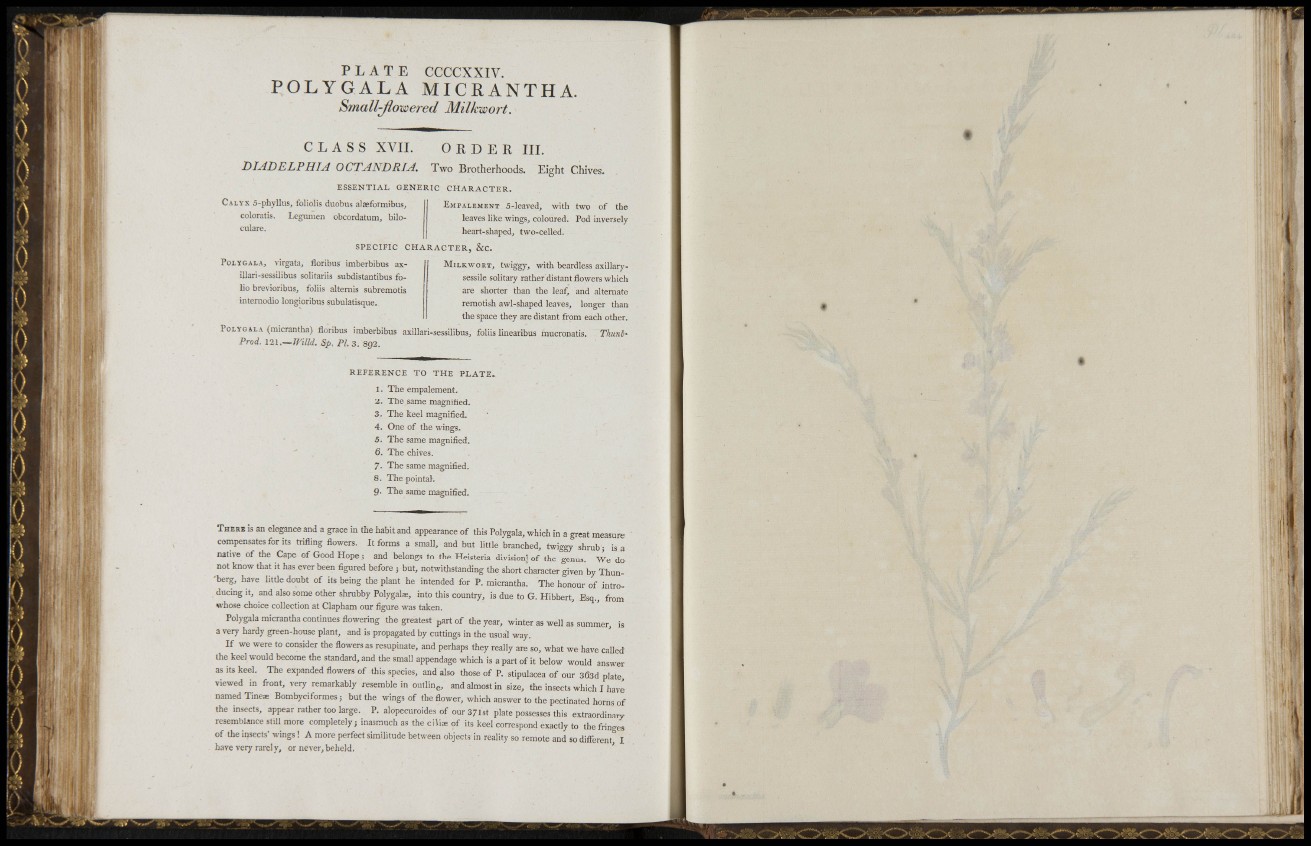
Ih î i
• i
I
li
If
-I
P L A T E CCCCXXIV.
P O L Y G A L A MICRANTHA.
Sìnall-Jìowered Milkwort.
C L A S S XVIL ORDER IIL
DL4DELPHL4 OCTANDRIA. Two Brotherhoods. Eight Chives.
ESSENTIAL GENERIC CHARACTER.
E M P A L E M E N T 5-leaved, with two of the
leaves like wings, coloured. Pod inversely
heart-shapedj two-celled.
SPECIFIC CHARACTER, &C.
M I L K W O R T , twigg}-, with beardless axillarysessile
solitary rather distant flowers which
are shorter than the leaf, and alternate
C i L Y X 5-phyllus, foliolis duobus alasformibns,
coloratis. Legunien obcordatum, biloculare.
PoLïGALA, virgata, floribus imberbibus axillari
sessilibus solitariis subdistantibus folio
brevioribus, foliis alternis subremotis
internodio longioribus subulatisque. reniotish awl-shaped leaves, longer than
the space they are distant from each otlier.
PoLYGALA (micrantha) floribus imberbibus axillari-sessilibus, foliis linearibus mucronatis. Tliunl-
Prod. 12l.—TVilld. Sp. PL 3. S92.
REFERENCE TO THE PLATE.
1. The empalement.
2. The same magnified.
3. The keel magnified.
4. One of the wings.
5. The same magnified.
6. The chives.
7. The same magnified.
8. Thepointal.
9. The same magnified.
THERE IS an elegance and a grace in the habit and appearance of this Polygala, which in a great measure
compensates for its trifling flowers. It forms a small, and but little branched, twiggy shi-ub • is a
native of the Cape of Good Hope; and belongs to the Heisteria division] of the genus. We do
not know tliat it has ever been figured before ; but, notwithstanding the short Character given by Thun-
-berg, have little doubt of its being the plant he intended for P. micrantha. The honour of introducing
it, and also some other shrubby Polygalae, into this country, is due to G. Hibbert, Esq., from
whose choice collection at Clapham our figure was taken.
Polygala micrantha continues flowering the greatest part of the year, winter as well as summer, is
a very hardy green-house plant, and is propagated by cuttings in the usual way.
I f we were to consider the flowers as resupinate, and perhaps they really are so, what we have called
the keel would become the standard, and the small appendage which is a part of it below would answer
as its keel. The expanded flowers of this species, and also those of P. stipulacea of our 363d plate
viewed in front, very remarkably resemble in outling, and almost in size, the insects which I havl
named Tinex Bombyciformes ; but the wings of the flower, which answer to the pectinated horns of
the insects, appear rather too large. P. alopecuroides of our 371st plate pos.sesses this extraordinary
resemblance still more completely; inasmuch as the ci\ise of its keel correspond exactly to the fringes
of the insects' wings ! A more perfect similitude between objects in reality so remote and so different, I
have very rarely, or never,beheld,
. ' j
I ' I; i'n
1 M
i -
r i4..